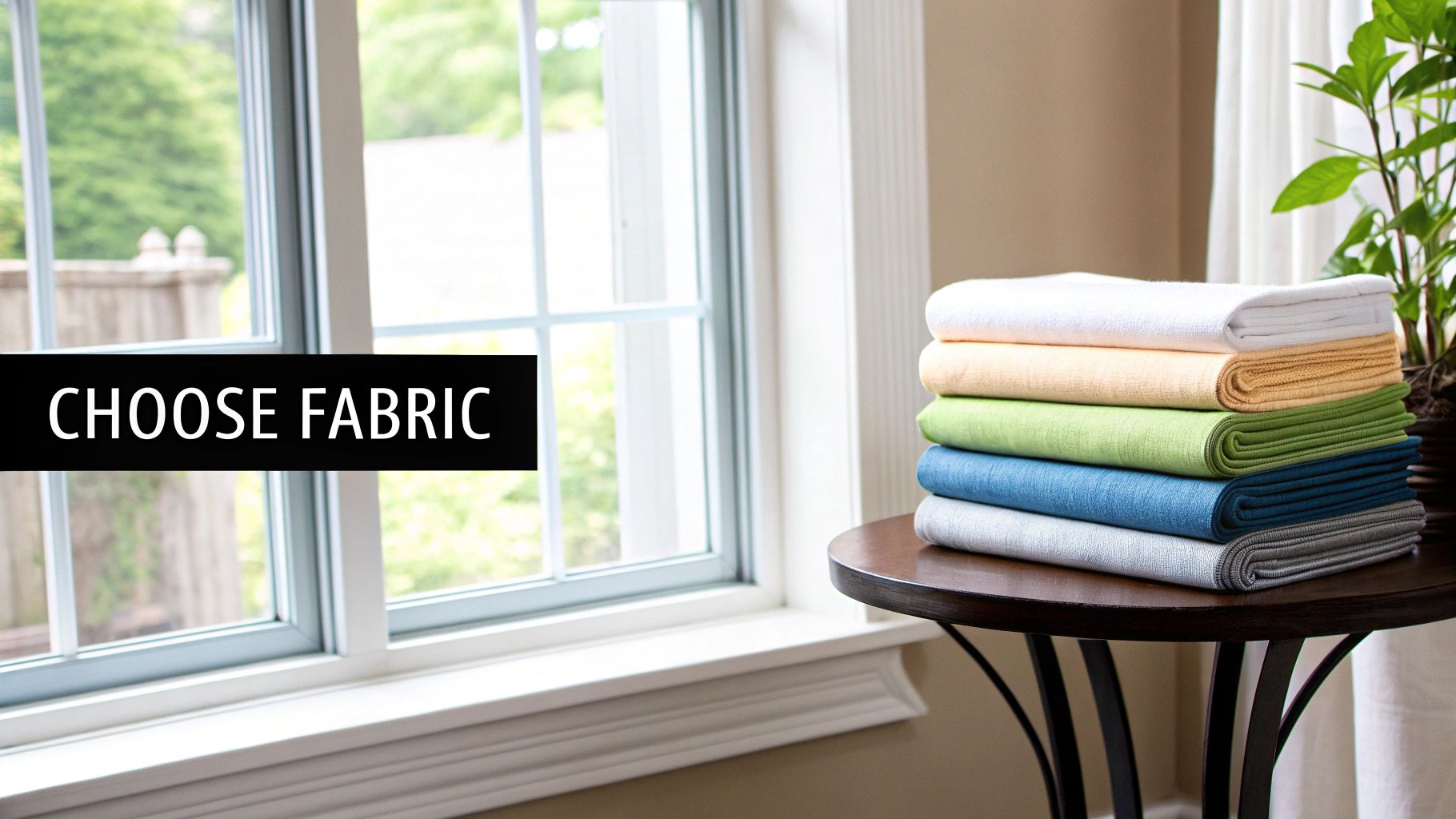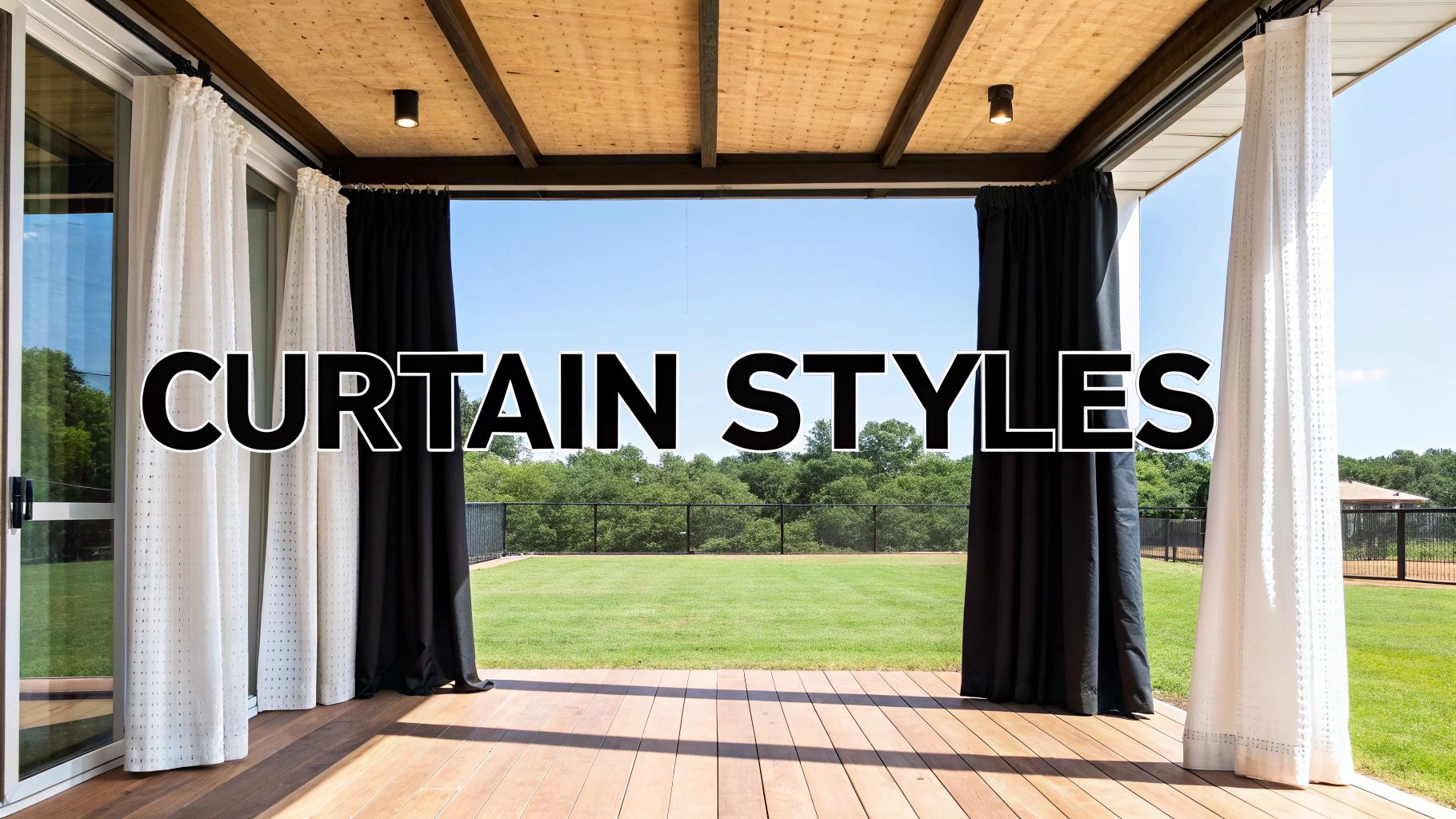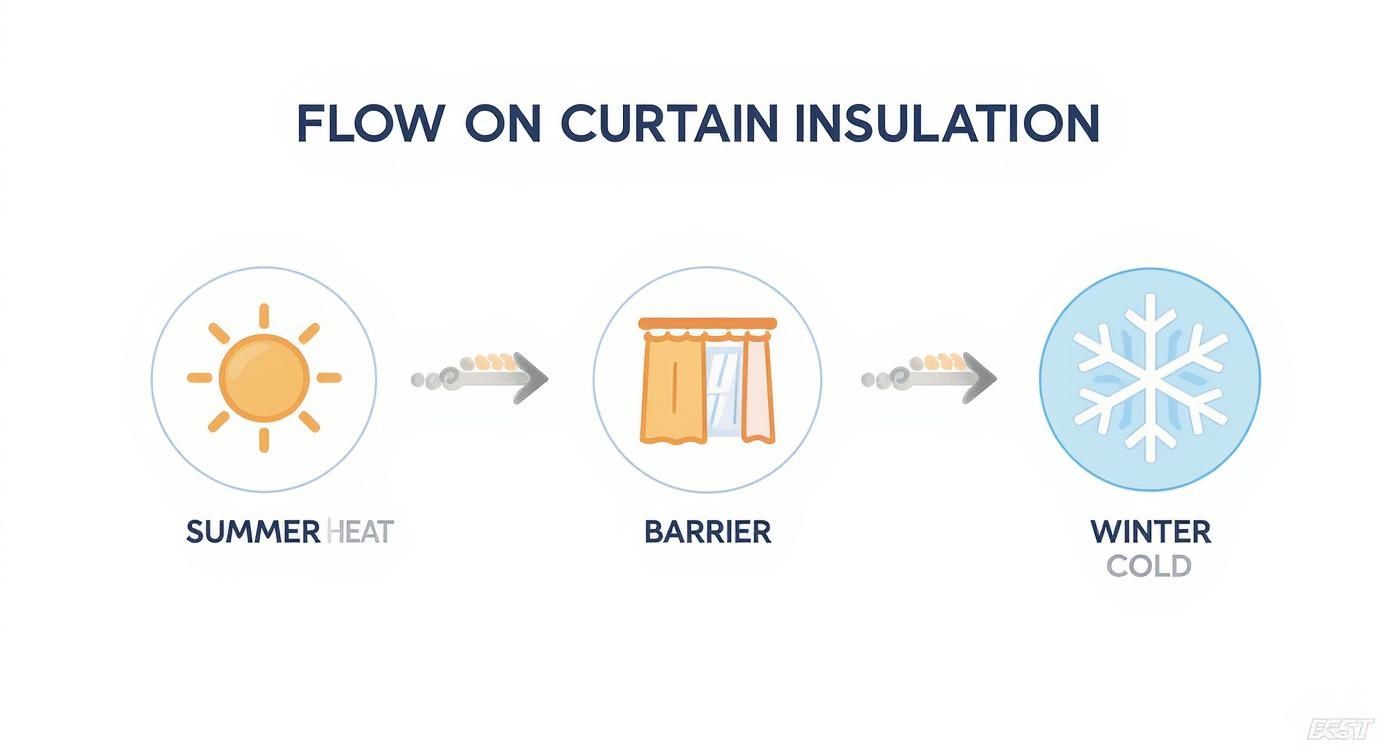
23 Curtain Ideas for Sunrooms to Perfect Your Sunny Escape
Table of Contents
- Why Your Sunroom Needs the Right Curtains
- Choosing the Right Fabric for Sun-Drenched Spaces
- Matching Curtain Styles to Your Sunroom's Design
- How to Balance Sunlight, Privacy, and Your View
- Using Curtains for Energy Efficiency and Insulation
- How to Measure and Install Sunroom Curtains
- Frequently Asked Questions About Sunroom Curtains
When it comes to sunrooms, the best curtain ideas lean into lightweight, UV-resistant fabrics. Think sheer linen or those amazing performance outdoor materials. These choices strike the perfect balance between controlling sunlight, protecting your furniture from fading, and keeping that airy, open vibe that makes a sunroom so special in the first place.
It's also smart to choose styles that are easy to open and close—like grommet top or tab top curtains—so you can adjust them as the sun moves across the sky.
Why Your Sunroom Needs the Right Curtains
Let's be honest, a sunroom without the right window treatments can quickly go from a dream to a nightmare. It gets too bright, way too hot, or feels like you're living in a fishbowl. The right curtains are so much more than just decoration; they're the control dial for your room's comfort and atmosphere.
Great curtain ideas for a sunroom are all about solving these common problems while making the space look fantastic. The main goal is to manage that intense sunlight without blocking your beautiful view. Because they’re essentially walls of glass, sunrooms are notorious for getting incredibly hot in the summer and losing heat in the winter. The right curtains act as a crucial layer of insulation, helping you regulate the temperature all year long.
This means you can actually enjoy your morning coffee without squinting into the sun and know your favorite armchair isn't slowly fading away.
A well-chosen curtain delivers on several fronts:
- Glare Reduction: It softens that harsh light, making the room so much more comfortable for reading a book or just relaxing.
- UV Protection: Think of it as sunscreen for your belongings. It acts as a shield to keep your sofas, rugs, and artwork from fading over time.
- Temperature Control: This is a big one. Curtains help keep the room cooler in the summer and warmer in the winter, which can even help trim your energy bills.
- Enhanced Privacy: They give you the power to create a secluded, cozy retreat whenever you want one.
Ultimately, the perfect curtains turn your sunroom into a versatile and inviting haven you can enjoy, no matter what the season brings.
Sunroom Curtain Quick Guide
To make things a bit simpler, I've put together a quick guide. Think of this as your cheat sheet for picking the perfect sunroom curtains based on what matters most to you.
| Consideration | Best Option | Why It Works |
|---|---|---|
| Light Control | Sheer or Light-Filtering Fabrics | Softens harsh sunlight and reduces glare while still letting you enjoy the natural light and the view. |
| UV Protection | Performance Outdoor Fabrics | These are specifically designed to resist UV rays, protecting your furniture and flooring from sun damage. |
| Privacy | Lined Curtains or Layered Sheers | Offers the flexibility to close off the room for privacy without making it feel dark or closed-in. |
| Insulation | Thermal-Lined Curtains | Acts as a barrier against heat gain in summer and heat loss in winter, making the room more comfortable. |
| Ease of Use | Grommet or Tab Top Styles | Super easy to slide open and closed, allowing you to adjust for changing light throughout the day. |
| Maintaining Vibe | Lightweight Linen or Cotton Blends | Keeps the space feeling airy and bright, perfectly matching the sun-filled nature of the room. |
Choosing curtains for a sunroom isn't just about covering windows—it's about enhancing the very reason you have the room in the first place. This table helps you match your needs with the right solution, ensuring your sunroom stays your favorite spot in the house.
Choosing the Right Fabric for Sun-Drenched Spaces
Picking the right material is probably the most important part of finding great curtain ideas for sunrooms. This one decision touches everything—from how the room glows to how much you spend on heating and cooling. Think of it like choosing the perfect pair of sunglasses; the material filters the light and completely changes how you see the world outside.
Lightweight, airy fabrics like sheer linen or a soft cotton blend are a fantastic choice if you want to create a gentle, diffused atmosphere. They take the edge off intense sunlight, cutting down on glare while still keeping the room feeling open and full of light. These are your go-to if the goal is to soften the light without blocking that beautiful view.

High-Performance Fabrics for Ultimate Protection
For those sunrooms that get blasted by the afternoon sun, you'll want to bring in the heavy hitters. High-performance fabrics are the workhorses of the curtain world, built to handle the toughest conditions.
- Outdoor Fabrics: Usually made from acrylic or polyester, these are engineered to fight back against fading, moisture, and mildew. They also provide excellent UV protection for your furniture, keeping it from getting sun-bleached.
- Thermal-Lined Curtains: These act as insulation for your windows. A special backing helps block out scorching heat in the summer and traps warmth inside during the winter, making your sunroom a comfortable spot no matter the season.
Want the secret to total control? It’s all about layering. Try pairing a light, sheer curtain with a heavier, opaque panel on a double rod. This setup gives you precise control—you can enjoy soft, filtered light all day, then draw the heavier layer for complete privacy or darkness when you need it.
Modern textile technology has given us some incredible options that are more durable and weather-resistant than ever before, perfect for sun-soaked spaces. The demand for these innovative fabrics is clear, with the global outdoor curtain market hitting USD 1.28 billion in 2024.
Getting to know the different materials is the key to making a choice you'll love for years. For a closer look at all the options, you can check out our comprehensive guide on curtain cloth types. These modern solutions offer superior performance and longevity, ensuring your sunroom curtains stay looking fantastic.
Matching Curtain Styles to Your Sunroom's Design
Once you’ve found the perfect fabric, the next step is all about personality—choosing a curtain style that clicks with your sunroom's unique vibe. The secret is in the header, which is the very top part of the curtain that connects to the rod. This small detail is what sets the entire design tone, making the difference between a breezy, coastal feel and a sharp, modern statement.
Your choice here pulls double duty, affecting both how the curtains look and how they work. It determines how they drape when they're closed and how easily they glide open for that morning sun. Getting this right is a huge part of creating a sunroom that feels thoughtful and put-together.

Classic and Casual Curtain Styles
If you're aiming for a relaxed, welcoming atmosphere, a couple of classic styles really shine with their simple charm. They fit right in with traditional, farmhouse, or even bohemian designs without any fuss.
- Rod Pocket Panels: This is that timeless, effortless look where the curtain rod just slips right through a sewn-in channel at the top. It creates soft, lovely gathers and is an ideal choice for curtains that you plan to keep in one spot.
- Tab Top Curtains: With visible loops of fabric that slide over the rod, this style has a handcrafted, almost rustic feel. It’s a wonderful way to add a bit of cottage-inspired character to your sunroom.
Modern and Creative Solutions
For sunrooms that lean more contemporary, you’ll want a style with cleaner lines and a bit more structure. These options deliver a polished, intentional look that pairs beautifully with minimalist or modern decor.
A great rule of thumb for curtain fullness is to choose panels that are at least twice the width of your window. This simple trick ensures they look lush and full when closed, not stretched thin.
Grommet-top curtains, for instance, use sleek metal rings to create wide, even pleats. They also slide open and closed with incredible ease, making them perfect for windows you'll be using often. If you have floor-to-ceiling glass, you might even consider a ceiling-mounted track. This lets your curtains glide smoothly across the entire wall, creating a stunning, seamless wall of fabric. For a look that truly ties your whole home together, professional interior design services can help perfectly integrate your sunroom curtains with your overall aesthetic.
How to Balance Sunlight, Privacy, and Your View
Finding the right curtains for a sunroom can feel like walking a tightrope. You built this space to enjoy the gorgeous view, but the intense glare can be a real problem, not to mention the need to protect your furniture and grab a little privacy now and then. The great news is you don't have to sacrifice one for the other.
So, what’s the secret? In short, it’s all about layering your window treatments. This simple strategy puts you in complete control, letting you adjust the light and privacy levels to match the time of day and your mood. Think of it as creating a custom filter for your windows.
The Power of Layering
Layering isn't just a design trick; it’s the most practical way to meet all the demands of a sunroom. By hanging two different types of curtains on a double curtain rod, you can tackle multiple challenges at once.
-
The Inner Layer (Sheers): Start with a lightweight, sheer curtain right up against the glass. This is your all-day filter. It softens that harsh sunlight, cuts the glare, and keeps you connected to your beautiful view. Joey'z Shopping has a lovely collection of sheer curtains that are perfect for this job.
-
The Outer Layer (Opaque or Lined Panels): On the second rod, hang something with a bit more substance—a heavier, opaque curtain. This could be a thick linen panel or even a thermal-lined drape. This layer is your "privacy on demand" solution, ready to be pulled closed for a cozy evening or to block out the intense afternoon heat.
This one-two punch gives you the best of both worlds. During the day, you can sweep back the outer layer and let the sheers do their gentle filtering. When you need more coverage, just draw the heavier panels closed.
As a rule of thumb, always choose curtain panels that are at least twice the width of your window. This ensures they look full and luxurious when closed, rather than stretched thin and looking a bit sad.
Smart Solutions for Specific Problems
Layering is fantastic, but it's not the only trick up our sleeve. Other curtain ideas for sunrooms can help with very specific issues. If your main goal is to dial down the sun's intensity without a full curtain, why not look at bamboo or woven wood shades? These natural materials add a wonderful texture and create a beautiful, dappled light effect.
For a sleeker, more modern vibe, top-down/bottom-up cellular shades are another brilliant option. You can lower the shade from the top, letting light pour in while keeping the bottom half covered for privacy. It’s the perfect fix for sunrooms that face the street or a neighbor's house.
Using Curtains for Energy Efficiency and Insulation
That gorgeous wall of glass in your sunroom is a double-edged sword, isn't it? While it floods your space with beautiful, natural light, it’s also a huge source of heat gain in the summer and heat loss in the winter. This can really drive up your energy bills. But the right curtains can transform from simple decor into a hardworking layer of insulation.
Think of thermal-lined curtains as a smart barrier for your windows. They work by creating a pocket of still air between the glass and your room, which dramatically slows down the transfer of heat. In the summer, they reflect the sun's heat back outside, keeping your sunroom feeling cool and comfortable. When winter rolls around, they do the exact opposite, trapping your home’s precious warmth right where it belongs—inside.
Investing in Comfort and Savings
This isn't just about feeling more comfortable throughout the year; it's a practical investment that actually pays you back. Properly insulated curtains can slash unwanted solar heat gain by up to 33%, which you'll definitely notice on your air conditioning bills during those hot summer months.
This blend of style and function is why the curtain market has seen such incredible growth. Valued at $29.2 billion in 2024, the global market is expected to climb to $47.8 billion by 2033. This boom means that specialized solutions, like curtains designed for the unique challenges of a sunroom, are more accessible than ever.
Choosing insulated curtains is one of the smartest things you can do for your sunroom. It’s a strategic move that merges great style with real-world function, making your space usable and cost-effective all year long.
By choosing the right materials, you’re turning your windows into an active part of your home’s energy management system. For a deeper dive into the specifics, check out our ultimate guide to insulated and thermal curtains. It’s a simple upgrade that makes sure your sunroom remains a perfect retreat, no matter what the weather is doing outside.
How to Measure and Install Sunroom Curtains
Bringing your sunroom curtain ideas to life really comes down to one thing: getting the installation right. It might seem a little intimidating, but all it takes is a few simple measurements to get that polished, professional finish you're looking for. The key is steering clear of common mistakes, like hanging the rod too low or picking panels that are too skinny for the windows.
The very first step, before you do anything else, is to measure your windows. A great rule of thumb is to install the curtain rod about 4 to 6 inches above the window frame. You'll also want it to extend 3 to 6 inches past the frame on each side. This little trick creates an illusion of a much bigger, grander window and gives your curtains space to stack neatly to the side when they're open, so you don't block that beautiful sunroom view.
Your Simple Installation Checklist
Once you've marked where the rod will go, the rest of the process is pretty straightforward. Accuracy is your best friend here, so grab a good tape measure and a level before you start.
- Measure for Width: For that full, luxurious look, your curtain panels should have a combined width that's at least 1.5 to 2 times the width of your window. This ensures they look lush and elegant when you close them, not like a stretched-out sheet.
- Determine the Length: Think about where you want your curtains to end. For a really elegant, flowing look, measure from the rod down so the curtains just "kiss" the floor. If you're going for something more practical, especially if you have furniture or heaters in the way, windowsill length is a great choice.
- Install Hardware Securely: Always use a level to make sure your brackets are perfectly even—no one likes a crooked curtain rod. If you're drilling into drywall, make sure to use anchors to properly support the weight of the rod and your new curtains.
If you'd like a more detailed walkthrough, our guide on how to measure curtains breaks down every single detail you'll need.
This visual shows how curtains act as a barrier, regulating temperature through the seasons.

It’s a simple concept: the same curtain barrier that effectively blocks out the summer heat also works to keep precious warmth inside during the winter.
Frequently Asked Questions About Sunroom Curtains
We’ve walked through everything from fabrics to installation, but I know there are always a few practical questions that come up when you're this close to making a decision. I hear them all the time. Let’s tackle those common queries head-on so you can finalize your choice with complete confidence.
Can I hang curtains in a sunroom without drilling?
Yes, you can absolutely hang curtains without drilling. The best drill-free solution is to use tension rods. These rods adjust to fit snugly inside your window frame and are perfect for lightweight fabrics like sheers. For heavier curtains, you can use high-quality, heavy-duty adhesive hooks, but always check the weight capacity to ensure they can support both the rod and curtains.
What are the best curtains for high humidity?
In a humid sunroom, you should choose moisture-resistant fabrics to prevent mildew and damage. The best options are polyester and acrylic because these synthetic materials naturally resist moisture and are very durable. Specialized outdoor fabrics are also an excellent choice, as they are engineered to withstand humidity and sun exposure.
Should my sunroom curtains touch the floor?
For a polished, high-end look, sunroom curtains should generally just touch or "kiss" the floor. This creates a sense of height and elegance. However, if you have baseboard heaters, pets, or small children, a practical alternative is to have the curtains end just above the floor or at the windowsill. The best length is always the one that suits your lifestyle.
Is it okay to use blackout curtains in a sunroom?
Yes, it is perfectly fine to use blackout curtains in a sunroom, especially if the space doubles as a media room, home office, or guest area. The best approach is to use a double rod system: hang light, airy sheer curtains on the inner rod for daytime filtering, and hang blackout panels on the outer rod for complete light control, privacy, and maximum insulation when needed.
Ready to find the perfect curtains to complete your sunroom? At Joey'z Shopping, we offer a wide variety of styles, fabrics, and hardware to bring your vision to life. Explore our collection and start creating your perfect sunny escape today.
